The global mushroom-powered skincare market is projected to grow from USD 1,723.4 million in 2025 to approximately USD 5,546.9 million by 2035, recording an absolute increase of USD 3,819.3 million over the forecast period. This translates into a total growth of 223.2%, with the market forecast to expand at a compound annual growth rate (CAGR) of 12.4% between 2025 and 2035. The overall market size is expected to grow by nearly 3.23X during the same period, supported by the rising consumer demand for natural skincare solutions and increasing awareness of mushroom-based ingredients' therapeutic benefits.
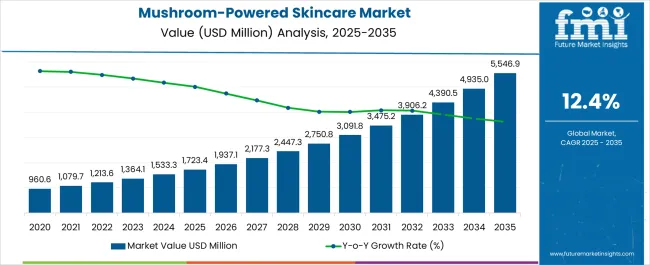
Between 2025 and 2030, the mushroom-powered skincare market is projected to expand from USD 1,723.4 million to USD 3,087.2 million, resulting in a value increase of USD 1,376.4 million, which represents 36.0% of the total forecast growth for the decade. This phase of growth will be shaped by increasing consumer awareness of adaptogenic skincare benefits, rising demand for clean beauty products, and growing penetration of mushroom-based ingredients in mainstream beauty formulations. Beauty brands are expanding their natural product portfolios to address the growing consumer preference for botanically-derived skincare solutions.
From 2030 to 2035, the market is forecast to grow from USD 3,087.2 million to USD 5,546.9 million, adding another USD 2,442.9 million, which constitutes 64.0% of the overall ten-year expansion. This period is expected to be characterized by expansion of premium mushroom skincare lines, integration of advanced extraction technologies, and development of specialized formulations targeting specific skin concerns. The growing adoption of personalized skincare routines and increasing availability through e-commerce channels will drive demand for innovative mushroom-powered beauty products.
Between 2020 and 2025, the mushroom-powered skincare market experienced rapid expansion, driven by increasing consumer interest in natural and sustainable beauty products and growing scientific research supporting mushroom-based ingredients' efficacy. The market developed as beauty brands recognized the potential of functional mushrooms in addressing various skin concerns, from anti-aging to hydration and brightening. Social media influencers and beauty experts began promoting mushroom skincare benefits, creating widespread consumer awareness and market adoption.
| Metric | Value |
|---|---|
| Estimated Value in (2025E) | USD 1,723.4 million |
| Forecast Value in (2035F) | USD 5,546.9 million |
| Forecast CAGR (2025 to 2035) | 12.4% |
Market expansion is being supported by the increasing consumer shift toward natural and clean beauty products and the corresponding recognition of mushroom-based ingredients' therapeutic properties. Modern consumers are seeking effective alternatives to synthetic skincare ingredients, driving demand for products containing functional mushrooms like reishi, chaga, and shiitake. Scientific research has validated the anti-aging, antioxidant, and skin barrier-supporting benefits of various mushroom extracts, creating credibility for these innovative formulations.
The growing wellness trend and increasing consumer education about adaptogenic ingredients are driving demand for mushroom-powered skincare products from both established beauty brands and emerging clean beauty companies. Social media platforms and beauty influencers are promoting the benefits of mushroom skincare, creating widespread awareness and consumer interest. E-commerce expansion and direct-to-consumer business models are making these specialized products more accessible to global consumers seeking natural skincare solutions.
The market is segmented by function, product type, claim, distribution channel, and region. By function, the market is divided into anti-aging, hydration, brightening, and repair & barrier support. Based on product type, the market is categorized into serums, creams/lotions, masks, and ampoules.
In terms of claim, the market is segmented into natural/organic, vegan, clean-label, and adaptogen-based products. By distribution channel, the market is classified into e-commerce, pharmacies, natural beauty stores, and specialty beauty retail. Regionally, the market is divided into North America, Europe, Asia Pacific, Latin America, and Middle East & Africa.
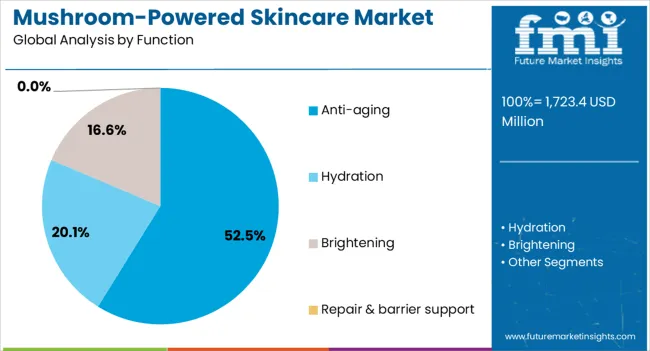
The anti-aging function is projected to capture 52.5% of the mushroom-powered skincare market in 2025. This leadership reflects the powerful role of functional mushrooms, such as reishi, chaga, and tremella, in combating visible signs of aging. Rich in antioxidants, beta-glucans, and bioactive polysaccharides, these extracts neutralize free radicals, support collagen synthesis, and improve overall skin resilience.
Their ability to reduce fine lines, improve elasticity, and promote cellular repair resonates strongly with consumers seeking natural alternatives to synthetic anti-aging actives. The segment is further strengthened by the rise of holistic beauty, where mushrooms are valued for both topical and ingestible applications, appealing to wellness-conscious buyers. Increasing clinical validation and strong marketing narratives around “ancient remedies meets modern science” enhance consumer confidence, ensuring that anti-aging remains the central growth engine of the mushroom-powered skincare category.
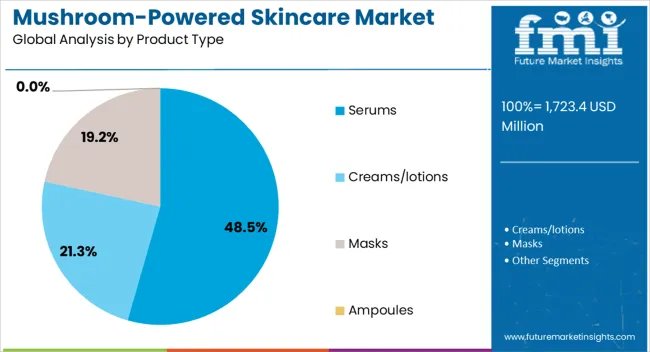
Serums are expected to command 48.5% of mushroom-powered skincare demand in 2025. Consumers increasingly seek concentrated treatments that provide high levels of active ingredients, and mushroom-based serums meet this demand by offering potent extracts in lightweight, fast-absorbing formulations. Their versatility allows for targeted benefits, including hydration, firming, and anti-aging, which can be seamlessly layered into multi-step routines.
Brands position serums as premium offerings, often backed by clinical claims, innovative extraction methods, and advanced delivery systems to enhance penetration. This aligns with consumer willingness to invest in targeted solutions that deliver visible results. The growth of clean beauty and wellness-oriented skincare further supports the rise of mushroom-powered serums, establishing them as both a functional and luxury-driven product type within this evolving category.
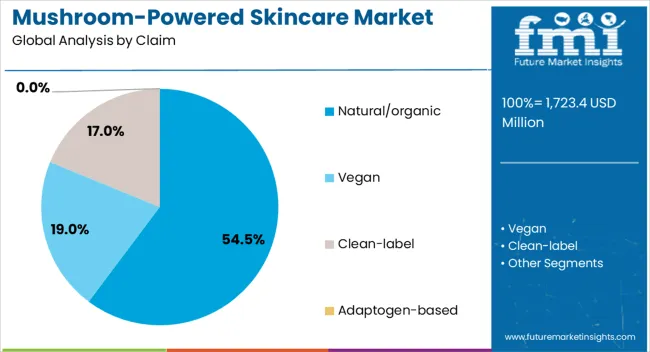
The natural/organic claim segment is forecasted to represent 54.5% of the mushroom-powered skincare market in 2025. This dominant share reflects growing consumer preference for authenticity, transparency, and sustainability in beauty products. Mushroom-powered formulations are particularly well-suited to organic positioning, as they are naturally derived and can be cultivated under controlled, eco-friendly conditions.
Certifications and third-party validations add credibility, reassuring buyers about purity and ethical sourcing. Consumers increasingly associate natural and organic claims with safety, gentleness, and long-term efficacy, motivating premium purchases in this space. Regulatory tightening across North America and Europe further drives standardization and trust in organic claims. With mushrooms already perceived as holistic and wellness-linked ingredients, aligning them with organic credentials strengthens their appeal, making this claim one of the strongest growth drivers within the segment.
The mushroom-powered skincare market is advancing rapidly due to increasing consumer awareness of natural beauty ingredients and growing scientific validation of mushroom-based skincare benefits. However, the market faces challenges including ingredient supply chain complexities, higher production costs compared to synthetic alternatives, and regulatory variations across different markets. Consumer education initiatives and ingredient standardization efforts continue to influence product development and market expansion patterns.
The growing integration of adaptogenic principles in skincare is driving development of mushroom-powered products that help skin adapt to environmental stressors and maintain optimal function. Brands are incorporating stress-fighting mushroom extracts that support skin's natural defense mechanisms and promote balanced skin health. This trend aligns with holistic wellness approaches that view skincare as part of overall health and well-being rather than purely cosmetic enhancement.
Advanced extraction methods and biotechnology applications are enabling more potent and stable mushroom-based skincare formulations. Brands are investing in proprietary extraction processes that preserve bioactive compounds while improving product stability and efficacy. Innovation in delivery systems, including encapsulation technologies and advanced carrier molecules, is enhancing the penetration and effectiveness of mushroom-derived ingredients in skincare applications.
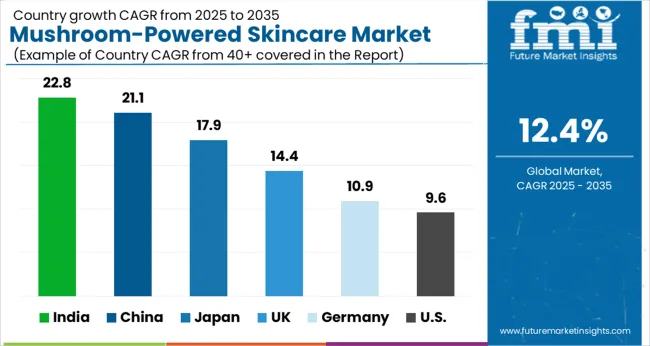
| Country | CAGR (2025 to 2035) |
|---|---|
| China | 21.1% |
| USA | 9.6% |
| India | 22.8% |
| Japan | 17.9% |
| United States | 9.6% |
| Germany | 10.9% |
The mushroom-powered skincare market is experiencing robust growth globally, with India leading at a 22.8% CAGR through 2035, driven by increasing wellness awareness and growing consumer interest in Ayurvedic and natural skincare traditions. China follows closely at 21.1%, supported by traditional Chinese medicine acceptance of mushroom benefits and rapid adoption of innovative beauty products. Japan grows at 17.9%, emphasizing premium ingredient quality and technological innovation in skincare formulations. Germany records 10.9% growth, focusing on organic certification and sustainable beauty practices. The United States shows steady growth at 9.6%, driven by the clean beauty movement and social media influence on consumer purchasing decisions.
Revenue from mushroom-powered skincare in China is projected to exhibit the highest growth rate with a CAGR of 21.1% through 2035, driven by cultural familiarity with medicinal mushrooms and rapid adoption of innovative beauty products. The country's expanding middle class and increasing disposable income are creating significant demand for premium natural skincare products. Traditional Chinese medicine principles support consumer acceptance of mushroom-based beauty benefits, creating favorable market conditions for product adoption.
Revenue from mushroom-powered skincare in India is expanding at a CAGR of 22.8%, supported by growing wellness consciousness and increasing integration of natural ingredients in beauty routines. The country's Ayurvedic tradition provides cultural context for accepting mushroom-based skincare benefits, while growing urbanization and income levels drive premium product adoption. Local and international brands are developing products specifically formulated for Indian skin concerns and climate conditions.
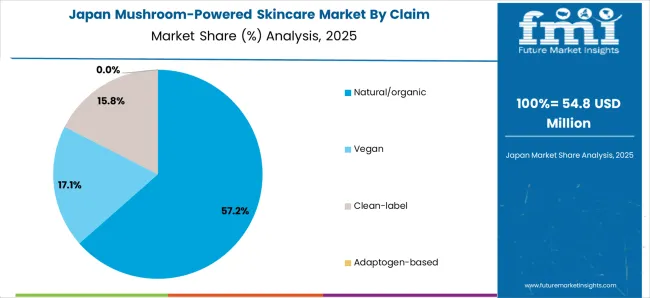
Demand for mushroom-powered skincare in Japan is projected to grow at a CAGR of 17.9%, supported by the country's sophisticated beauty culture and consumer appreciation for ingredient innovation. Japanese consumers prioritize product quality and efficacy, creating opportunities for premium mushroom skincare formulations with proven benefits. The market emphasizes technological advancement in extraction methods and delivery systems that enhance mushroom ingredient effectiveness.
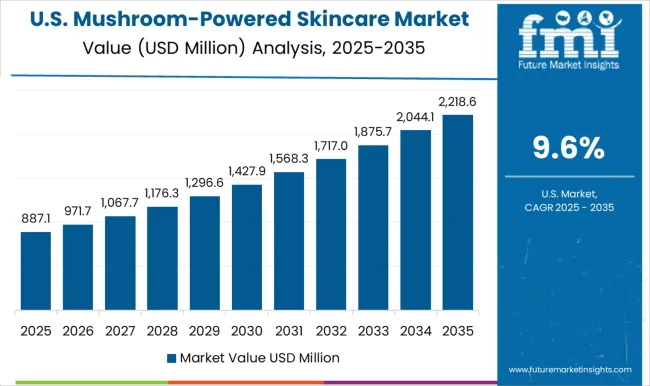
Demand for mushroom-powered skincare in the USA is expanding at a CAGR of 9.6%, driven by the clean beauty movement and increasing consumer demand for transparent ingredient sourcing. American consumers are seeking alternatives to synthetic skincare ingredients, creating opportunities for mushroom-based formulations that offer natural efficacy. Social media influence and celebrity endorsements are accelerating product awareness and market adoption across demographic segments.
Demand for mushroom-powered skincare in Germany is projected to grow at a CAGR of 10.9%, supported by strong consumer preference for certified organic products and sustainable beauty practices. German consumers prioritize environmental responsibility and ingredient authenticity, driving demand for certified organic mushroom skincare products with traceable supply chains. The market emphasizes compliance with strict European Union regulations for natural and organic cosmetics.
Demand for mushroom-powered skincare in the UK is projected to grow at a CAGR of 14.4%, supported by rising consumer interest in natural, plant-based beauty solutions and increasing adoption of functional mushrooms in premium skincare formulations. British consumers value ingredient transparency, sustainability, and dermatological validation, positioning mushroom-derived actives as a key trend within the clean beauty and wellness space.

The mushroom-powered skincare market is characterized by competition among established beauty brands, emerging clean beauty companies, and specialized natural skincare manufacturers. Companies are investing in ingredient research, sustainable sourcing, innovative formulations, and consumer education to deliver effective, authentic, and environmentally responsible mushroom-based skincare solutions. Strategic partnerships, ingredient innovation, and brand positioning are central to building market presence and consumer loyalty.
Origins leads the global market with an 8% value share in 2025, leveraging its natural skincare expertise and established retail presence to promote mushroom-powered products. The company emphasizes ingredient efficacy and sustainable sourcing while maintaining premium positioning in the natural beauty segment.
Youth to the People focuses on millennial and Gen Z consumers with clean formulations and transparent ingredient communication. Herbivore Botanicals emphasizes minimalist formulations and aesthetic packaging that appeals to conscious consumers. Dr. Andrew Weil for Origins combines medical expertise with natural ingredient knowledge to create credible mushroom skincare solutions.
Moon Juice targets wellness-focused consumers with adaptogenic beauty concepts and holistic health positioning. The Body Shop integrates mushroom ingredients into its natural product portfolio with ethical sourcing initiatives. Innisfree leverages Korean beauty innovation with mushroom-based formulations for Asian markets. Tatcha emphasizes Japanese beauty traditions and premium ingredient quality. Fresh and Sunday Riley focus on innovative formulations and luxury positioning in the mushroom skincare segment.
| Items | Values |
|---|---|
| Quantitative Units (2025) | USD 1,723.4 million |
| Function | Anti-aging, Hydration, Brightening, Repair & Barrier Support |
| Product Type | Serums, Creams/Lotions, Masks, Ampoules |
| Claim | Natural/Organic, Vegan, Clean-label, Adaptogen-based |
| Distribution Channel | E-commerce, Pharmacies, Natural Beauty Stores, Specialty Beauty Retail |
| Regions Covered | North America, Europe, Asia Pacific, Latin America, Middle East & Africa |
| Countries Covered | United States, Canada, United Kingdom, Germany, France, China, Japan, India, Brazil, Australia and 25+ countries |
| Key Companies Profiled | Origins, Youth to the People, Herbivore Botanicals, Dr. Andrew Weil for Origins, Moon Juice, The Body Shop, Innisfree, Tatcha, Fresh, and Sunday Riley |
| Additional Attributes | Dollar sales by mushroom species and extract type, regional demand trends, competitive landscape, buyer preferences for adaptogenic versus antioxidant claims, integration with clean-label/vegan positioning, innovations in fermentation, bioactive concentration, and sustainable cultivation practices |
The global mushroom-powered skincare market is estimated to be valued at USD 1,723.4 million in 2025.
The market size for the mushroom-powered skincare market is projected to reach USD 5,546.9 million by 2035.
The mushroom-powered skincare market is expected to grow at a 12.4% CAGR between 2025 and 2035.
The key product types in mushroom-powered skincare market are natural/organic , vegan, clean-label and adaptogen-based.
In terms of function , anti-aging segment to command 52.5% share in the mushroom-powered skincare market in 2025.






Full Research Suite comprises of:
Market outlook & trends analysis
Interviews & case studies
Strategic recommendations
Vendor profiles & capabilities analysis
5-year forecasts
8 regions and 60+ country-level data splits
Market segment data splits
12 months of continuous data updates
DELIVERED AS:
PDF EXCEL ONLINE
Skincare Supplement Market Size and Share Forecast Outlook 2025 to 2035
Skincare Oil Market Size and Share Forecast Outlook 2025 to 2035
Skincare Nutritional Serum Market Size and Share Forecast Outlook 2025 to 2035
Skincare Products Market Size and Share Forecast Outlook 2025 to 2035
Skincare Market Analysis - Size, Share, and Forecast Outlook 2025 to 2035
Skincare Packaging Market Size, Share & Forecast 2025 to 2035
Skincare Industry in India – Trends & Growth Forecast 2024-2034
Global Skincare Treatment Market Analysis – Size, Share & Forecast 2024-2034
Global PDRN Skincare Market Size and Share Forecast Outlook 2025 to 2035
Men’s Skincare Products Market Size, Growth, and Forecast for 2025 to 2035
Global Smart Skincare Market Size and Share Forecast Outlook 2025 to 2035
Cooling Skincare Gels Market Size and Share Forecast Outlook 2025 to 2035
Natural Skincare Preservatives Market Analysis - Size and Share Forecast Outlook 2025 to 2035
Ormedic Skincare Market Demand & Insights 2024-2034
Ceramide Skincare Market Size and Share Forecast Outlook 2025 to 2035
BPA-Free Skincare Market Trends – Demand & Forecast 2024-2034
Camellia Skincare & Cosmetics Market
Buffering Skincare Products Market Analysis - Size and Share Forecast Outlook 2025 to 2035
Menopause Skincare Solutions Market Size and Share Forecast Outlook 2025 to 2035
Probiotic Skincare Ingredients Market Size and Share Forecast Outlook 2025 to 2035

Thank you!
You will receive an email from our Business Development Manager. Please be sure to check your SPAM/JUNK folder too.
Chat With
MaRIA